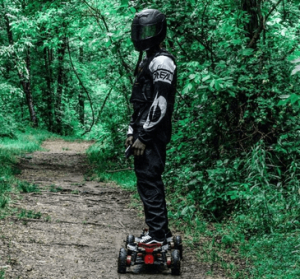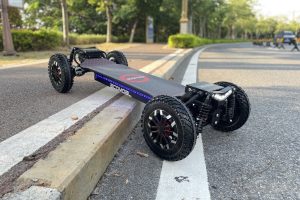Electric skateboards handle quite differently than regular skateboards since they have powerful motors that can accelerate quickly. To ride an electric board safely and effectively, it’s important to understand the key parts and how they work. Before taking your electric board for a spin, I’d recommend familiarizing yourself with each component and how they interact. This will help keep you safe as you learn the ins and outs of riding. At the end of the day, knowing what each piece does is crucial both for your safety and for having a good time out there.

Understanding the Basics
When learning to ride an electric skateboard, prioritizing safety is key. In addition to understanding your board’s components, wear protective gear to avoid injury.
A sturdy helmet is essential. It shields your head if you fall at the fast speeds electric skateboards can reach. Knee pads, elbow pads, and wrist guards are also highly advisable. They help prevent scrapes and sprains during tumbles.
Wearing full protective coverings allows one to focus on mastering controls instead of worrying about injuries. Electric skateboards accelerate swiftly and move much quicker overall than regular boards. Without protection, falls could lead to more harm.
The full safety setup gives new riders confidence to push limits as skills develop. It provides assurance when learning to finely control the acceleration, braking, and turning of an electric skateboard. Start slowly, but with the right gear, you can progress at your own pace.
Learning the Controls
Accelerating, braking, and steering are fundamental maneuvers for any rider to master. On an electric skateboard, these actions are controlled remotely rather than by the rider’s feet. To accelerate, simply push the joystick or trigger on the remote forward in the direction you wish to travel. Be gentle at first as the motor can surge quickly. For braking, either pull back on the remote joystick or press a designated brake button to slow down. Some boards allow “engine braking” just by releasing the remote’s throttle. It is wise while learning to practice gradual braking and low-speed coasting to get comfortable with your board’s adjustments. Steering is accomplished through subtle shifting of weight like on a regular skateboard, but the boosted speed requires early, smooth turns rather than abrupt inputs. Fundamental techniques like these will allow new riders to confidently explore using power.
Mastering Techniques
Once you feel comfortable with basic riding maneuvers, you can start honing your skills. Practicing on flat, open ground is ideal for improving technique.
Carving
Carving is making wide, arcing turns by subtly shifting your weight from one edge of the board to the other. Start by leaning gently in the direction you want to turn. As you turn, slowly transfer your weight to the opposite edge to smoothly come out of the carve. Keep your knees bent and body low to better control the board. Carving builds up your stability and weight transfer abilities.
Uphill Riding
Riding up hills takes precise throttle control. Accelerate gradually as you approach the incline. Maintain consistent speed as you climb the hill while keeping your weight centered over the board. Don’t accelerate suddenly or brake abruptly while on the slope. Time your acceleration at the bottom to avoid losing momentum halfway up. With practice controlling your speed uphill, you’ll be able to handle any inclines.
Downhill Riding
Use caution when riding downhill, as electric boards can quickly gain speed. Gently apply the brakes as you begin descending to control your speed. Keep your weight back and knees bent to remain balanced as you pick up speed. Avoid sudden braking or turning on steep hills. Look ahead and be prepared to stop or slow down if needed. Mastering downhill riding takes experience controlling speed.
Maintenance and Storage
Taking good care of your electric skateboard is important to keep it working properly and safely over time.
The lithium batteries that give power to the motors need to be handled gently to prevent damage. Be sure to only use the charger provided by the manufacturer and watch the charging fully until it’s complete. This avoids overcharging the sensitive battery cells. When you’re not using it, store the board at room temperature away from very hot or cold places like attics or garages which could shorten the battery’s life.
In addition to the battery, regularly check key parts like the trucks, wheel bearings, drive belts, and mounting bolts. The vibrations and stresses of riding on rough ground can loosen these parts after a while. Tightening any loose fasteners and replacing worn-out parts every so often prevents bigger problems later on.
Follow the recommendations from the manufacturer for cleaning and maintenance after each use. Wiping down the deck to remove corrosive dirt buildup and occasionally oiling the bearings will help prevent deterioration. Re-tightening the trucks and checking the tightness of the mounting hardware ensures good stability and steering.
Keeping a maintenance log to document any issues noticed during regular checks is wise. Detailed records make troubleshooting easier so small problems can be fixed before causing bigger issues.
Building consistent care and upkeep will allow your electric skateboard to deliver miles of exciting rides and keep you safe year after year.

Conclusion
Taking good care of your electric skateboard is key to ensuring it lasts as long as possible. Proper charging and storage are especially important for the battery. Be sure to only use the charger that came with the board. And you can keep an eye on the temperature during and after charging to avoid overheating.
For storage, a cool, dry place without extreme temperatures is best. Storing the battery at around 40% charge will help it maintain its balance over time. Riding puts wear and tear on a board, so regular maintenance is a must. Give it a quick clean after each use to remove dirt. Also, check all the connections periodically to make sure nothing has come loose from vibrations.
Don’t forget that the battery is just as vital to care for as any other component. Following these tips on charging, storage and maintenance can not only improve safety and performance but significantly extend the life of your battery. That means you’ll be able to enjoy electric skateboarding for many miles to come! Taking good care of the “fuel” that powers the board is what keeps it running smoothly.
FAQs
Electric skateboarding is an exciting new way to travel and have fun, but many new riders have questions. Below are answers to some frequently asked questions:
Q1: What is the ideal weight limit for most electric boards?
While limits vary by model, most can support riders up to 220-250 pounds. Heavier individuals may want to consider extra durable or commercial-grade options.
Q2: How long does the battery last on a single charge?
Runtime varies significantly depending on rider weight, terrain, and use of top speeds. But most high-quality batteries can provide a range of 10-25 miles on a charge.
Q3: Is electric skateboarding legal on roads/paths where I live?
Laws are evolving but generally, electric boards should not be used on sidewalks and may only be road-legal up to 20mph, depending on local statutes. Always check and obey regulations to avoid fines.
Q4: How difficult is it for beginners to learn?
With patience and all proper safety gear, electric skateboarding is very approachable for novices. Take time to learn controls slowly at first in open areas away from traffic.
Read More
- City Hacking Electric Skateboard Tips – Ecomobl
- Best Electric Longboard Skateboard For Under 700 – Ecomobl
- The Best Electric Skateboard With An Affordable Price – Ecomobl
- Beginners Electric Skateboards Guide – Ecomobl
- Electric Skateboarding Fitness – Ecomobl




